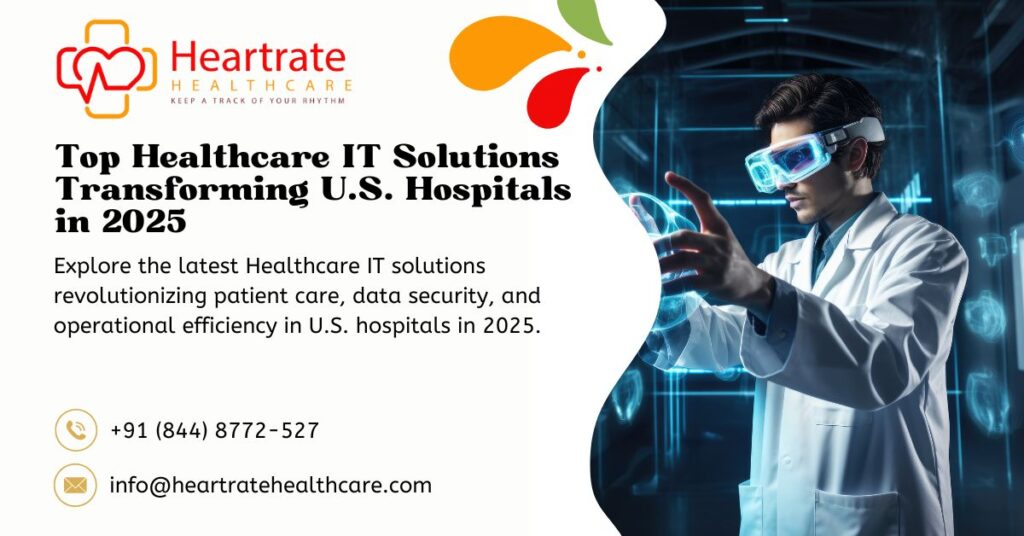The U.S. healthcare industry is experiencing a massive digital transformation in 2025, with hospitals adopting cutting-edge IT solutions to enhance patient outcomes, streamline operations, and address ongoing challenges such as staff shortages and rising costs. From AI-powered diagnostics to advanced telehealth platforms, the future of healthcare is being shaped by technology. In this article, we explore the top healthcare IT solutions that are redefining U.S. hospitals this year.
1. Artificial Intelligence (AI) in Diagnostics and Treatment
AI continues to be one of the most powerful tools in modern healthcare. In 2025, AI algorithms are being widely used for:
- Medical Imaging Analysis – AI tools analyze X-rays, MRIs, and CT scans faster and more accurately than human radiologists.
- Predictive Analytics – Hospitals use AI to predict patient deterioration, allowing for proactive treatment and improved outcomes.
- Clinical Decision Support – AI-driven systems provide physicians with data-backed treatment recommendations.
AI helps reduce errors, improve diagnosis speed, and free up valuable time for healthcare providers.
2. Electronic Health Records (EHR) 2.0
While EHRs have existed for years, the 2025 versions are smarter, faster, and more interoperable:
- Voice-Powered Data Entry – Doctors can now dictate notes using natural language processing, reducing admin time.
- Cross-Platform Compatibility – Patients’ records are easily shared across hospitals, specialists, and even across states.
- Integrated Patient Portals – Patients can access lab results, appointment schedules, and prescriptions all in one place.
EHR 2.0 ensures continuity of care and empowers patients through better access to their health information.
3. Telehealth and Remote Patient Monitoring
Since the pandemic, telehealth has become a staple in healthcare delivery, and in 2025, it’s even more advanced:
- Virtual Consultations – Doctors see patients via secure video calls, reducing wait times and geographic barriers.
- Wearable Tech Integration – Devices like smartwatches monitor vitals and send data directly to healthcare providers.
- Chronic Disease Management – Remote monitoring tools help manage diabetes, hypertension, and heart conditions effectively.
Telehealth improves access, especially in rural or underserved communities.
4. Cybersecurity and Data Protection
As healthcare systems become increasingly digital, so does the risk of cyberattacks. In 2025, hospitals are investing in:
- Zero-Trust Security Architecture – Verifying every user, device, and connection before granting access.
- Advanced Threat Detection Systems – Using machine learning to detect and stop potential breaches in real-time.
- Data Encryption and Compliance – Ensuring HIPAA and GDPR regulations are met for patient privacy.
Data security is now non-negotiable, with hospitals prioritizing patient trust and regulatory compliance.
5. Hospital Automation with IoT and Robotics
Internet of Things (IoT) devices and robotic systems are automating hospital tasks such as:
- Smart Beds and Equipment – IoT-enabled beds adjust based on patient needs and monitor vitals.
- Automated Medication Dispensers – Robots dispense drugs accurately, minimizing errors and freeing up nurses.
- Facility Management – IoT sensors monitor temperature, humidity, and hygiene levels in critical care areas.
Automation enhances efficiency and allows medical staff to focus more on patient care.
6. Cloud-Based Infrastructure
Hospitals are rapidly migrating to the cloud to enjoy benefits like:
- Scalability – Storage and computing power can be adjusted as needed.
- Remote Access – Doctors can securely access patient records and imaging from anywhere.
- Disaster Recovery – Cloud backups protect against data loss in emergencies.
Cloud platforms also enable easier collaboration between healthcare providers and researchers.
7. Patient-Centric Mobile Apps
In 2025, mobile health apps are not just optional—they’re essential:
- Health Tracking – Apps sync with wearable devices to track steps, heart rate, sleep, and more.
- Appointment Scheduling – Patients book, reschedule, or cancel appointments with a few taps.
- Two-Way Messaging – Secure communication channels between patients and healthcare teams.
These apps improve engagement and encourage healthier behaviors through digital convenience.
8. Virtual Reality (VR) and Augmented Reality (AR)
VR and AR are no longer limited to entertainment—they’re playing a critical role in healthcare:
- Surgical Training – Medical students and surgeons use VR simulations for practice.
- Pain Management – VR environments help distract and relax patients during painful procedures.
- AR-Guided Surgeries – AR overlays guide surgeons with real-time visuals and precision tools.
These immersive technologies enhance learning and patient experience alike.
9. Interoperability and Data Exchange Standards
As multiple IT systems coexist in healthcare, seamless communication between them is crucial:
- FHIR Standards – The Fast Healthcare Interoperability Resources (FHIR) framework enables smoother data exchange.
- Health Information Exchanges (HIEs) – Regional platforms connect providers and labs for faster diagnoses.
- Unified Health Records – Efforts are underway to create a single patient record accessible across systems.
Improved interoperability reduces duplicate tests, saves costs, and improves patient care coordination.
Conclusion
2025 is a landmark year for healthcare IT. As hospitals continue adopting advanced solutions, the patient experience becomes more seamless, personalized, and efficient. These technologies are not just transforming operations—they’re redefining the future of healthcare delivery in the U.S.
Whether you’re a healthcare provider, tech investor, or patient advocate, understanding these IT innovations is key to staying ahead in this rapidly evolving industry.

